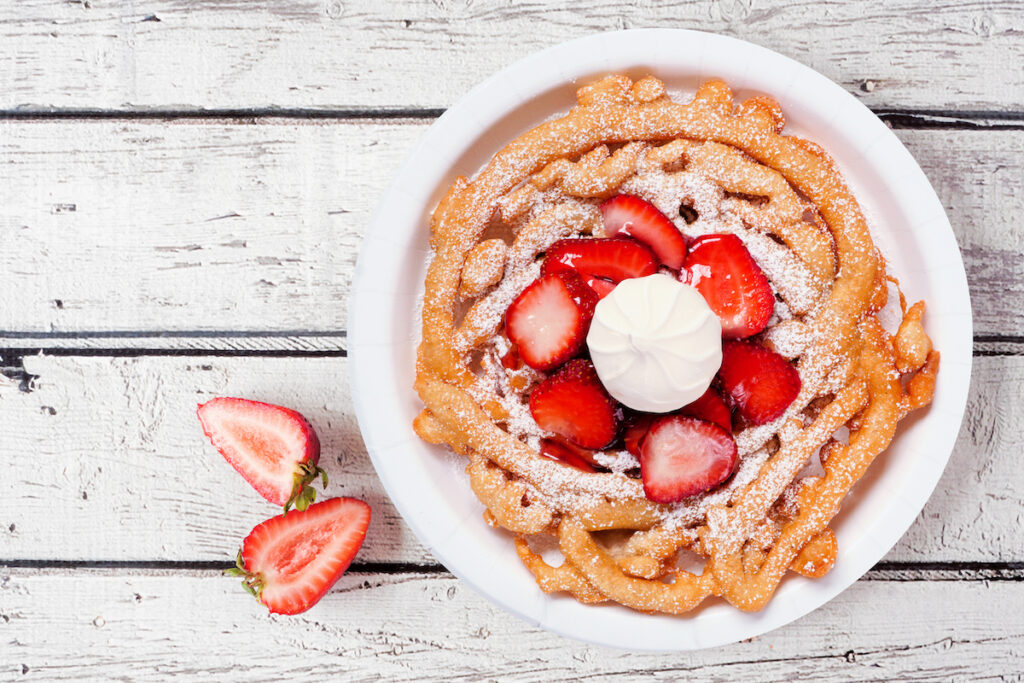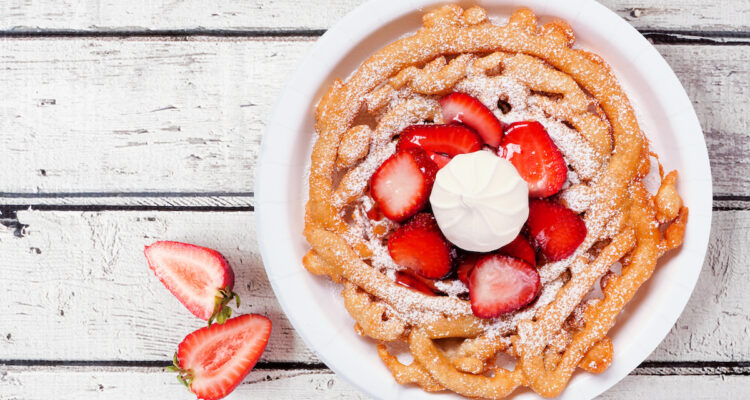
Funnel cake is a beloved carnival and fair food that has been enjoyed for generations. The sweet, crispy treat is made by pouring batter through a funnel into hot oil, creating a unique, swirled shape. While funnel cake is a staple of American fairs and carnivals, it has a rich history that dates back centuries.
History
The origins of funnel cake can be traced back to medieval Europe, where it was known by various names such as “mincebek,” “mistembec,” or “cryspes.” The dessert was made by pouring batter through a funnel into hot oil, creating a crispy, fried pastry. Over time, the dessert spread throughout Europe. Eventually, he recipe for funnel cake was brought to America by German immigrants who settled in Pennsylvania in the 17th and 18th centuries, becoming a popular fair and carnival food.
Origins
The exact origins of funnel cake are unclear, but it is believed to have originated in Europe. The first recorded recipe for funnel cake appeared in a German cookbook in the late 19th century. However, similar fried dough desserts can be found in many cultures, such as the Dutch oliebollen, the Scandinavian rosette, and the Italian zeppole.
Popularity in the US
Funnel cake became popular in the United States in the mid-20th century, particularly at state fairs and carnivals. It is now a staple at many outdoor events and amusement parks across the country. In the U.S., funnel cakes were originally associated with Pennsylvania Dutch Country. It is one of the first North American fried foods, which is associated with the Pennsylvania Dutch, German immigrants who came to Pennsylvania in the 17th and 18th centuries.
Today, funnel cakes are enjoyed by people of all ages and backgrounds. They are often served with powdered sugar, but can also be topped with various other toppings such as cinnamon, chocolate, jelly, and fruit. Some people even enjoy dipping their funnel cake in chocolate or caramel sauce.
I love to make funnel cakes for summer parties and family gatherings. Dusted with strawberry-flavored powdered sugar, those delicious creations disappear in minutes! Sometimes, I coat them with melted white chocolate and sprinkle strawberry-flavored sprinkles on top.
Funnel Cake Recipe
Ingredients
Making funnel cake is surprisingly easy and requires only a few simple ingredients that you likely already have in your pantry:
- 2 cups all-purpose flour
- 2 tablespoons granulated sugar
- 1 teaspoon baking powder
- 1/2 teaspoon salt
- 1 cup whole milk (or more, if needed)
- 2 large eggs
- 1/2 teaspoon vanilla extract (optional)
- Neutral-tasting vegetable oil (like canola) for frying
Instructions
Follow these simple steps to create your own delicious funnel cakes:
- In a medium-sized mixing bowl, whisk together the flour, sugar, baking powder, and salt.
- In a separate large mixing bowl, whisk together the milk, eggs, and vanilla extract until properly combined.
- Add the dry ingredients to the wet ingredients and whisk until smooth.
- Heat about 1 inch of vegetable oil in a large, deep-sided pan or pot over medium-high heat until it reaches 375 °F (190 °C).
- Pour the batter into a squeeze bottle or a large ziplock bag with one corner snipped off. (Don’t make too large opening, though.)
- Carefully drizzle the batter into the hot oil in a spiral pattern, making sure to overlap the batter to create a lacy, web-like pattern.
- Cook the funnel cake for 1—2 minutes on each side or until golden brown and crispy.
- Remove the funnel cake from the oil using a slotted spoon. Transfer the cake to a paper towel-lined plate to drain the excess oil.
- Serve the funnel cake warm, dusted with powdered sugar or topped with your favorite toppings.
Tips
When it comes to making funnel cakes, there are a few tips that can help ensure success. Below are some key tips to keep in mind:
Equipment
Having the right equipment is essential for making funnel cakes. A funnel with a narrow opening is needed to pour the batter into the oil. It is also important to have a deep fryer or a large pot with enough oil to fully submerge the funnel cake. A slotted spoon (or tongs, however, the slotted spoon is better) can be used to flip the cake and remove it from the oil. A thermometer can also be helpful to monitor the temperature of the oil.
Batter Consistency
The consistency of the batter is crucial for creating the perfect funnel cake. If the batter is too thick, it will not flow easily through the funnel, resulting in a cake that is too dense. If the batter is too thin, it will spread out too much in the oil and not hold its shape. A good rule of thumb is to aim for a consistency that is similar to pancake batter. It should be thin enough to flow easily but thick enough to hold its shape.
Frying Temperature
The temperature of the oil is also important for creating a crispy, golden brown funnel cake. If the oil is too hot, the cake will brown too quickly on the outside while remaining raw on the inside. If the oil is not hot enough, the cake will absorb too much oil and become greasy. The ideal temperature for frying funnel cakes is between 375—400 °F (190—200 °C). Use a thermometer to monitor the temperature and adjust the heat as needed. Remember that the hot oil can catch fire, so never ever overheat your oil to prevent it from creating a grease fire.
Cooking the funnel cakes
To make perfect funnel cakes, it’s important to work quickly and avoid overcrowding the pan. Cook one funnel cake at a time, making sure to give each cake plenty of room to expand and cook evenly.
Variations
While funnel cakes are traditionally served with powdered sugar, there are many variations that can be made to this classic fair food. Here are a few ideas for toppings and flavors to try:
Toppings
Funnel cakes can be topped with a variety of toppings to suit your taste preferences. Some popular options include:
- Fruit: Fresh or canned fruit or berries can be added on top of the powdered sugar for a fruity twist. Strawberries are the most popular topping.
- Jam: You can top your funnel cakes with various jams.
- Chocolate: Drizzle melted chocolate over the funnel cake for a decadent treat. As I said, I love to coat my funnel cakes by dipping them in melted white chocolate. Feel free to use food coloring to white chocolate to create even more festive colors.
- Caramel: Add a drizzle of caramel sauce for a sweet and sticky topping. Alternatively, dip the funnel cakes in warm caramel and let set, just like you would prepare caramel apples. This works well for smaller funnel cakes.
- Whipped Cream: Top the funnel cake with a dollop of whipped cream for a light and fluffy addition. Feel free to sprinkle colorful sprinkles on top for extra crunch and joyful colors. Alternatively, you can add sliced fruit or berries on top of whipped cream for the ultimate indulgence.
Flavors
While the classic funnel cake is made with a simple batter, there are many ways to add flavor to the mix. Here are a few ideas to try:
- Cinnamon: Add a teaspoon of cinnamon to the batter for a warm and spicy flavor.
- Vanilla: Add a teaspoon of vanilla extract to the batter for a sweet and fragrant twist.
- Chocolate: Mix in 1 tablespoon dark cocoa powder to the batter for a chocolatey funnel cake.
- Fruit: Add 1/4 cup pureed fruit or jam to the batter for a fruity flavor. If you use sweet jam, adjust the sugar accordingly.
These are just a few ideas to get you started, but the possibilities for funnel cake variations are endless. Get creative and experiment with different toppings and flavors to find your perfect funnel cake combination!

